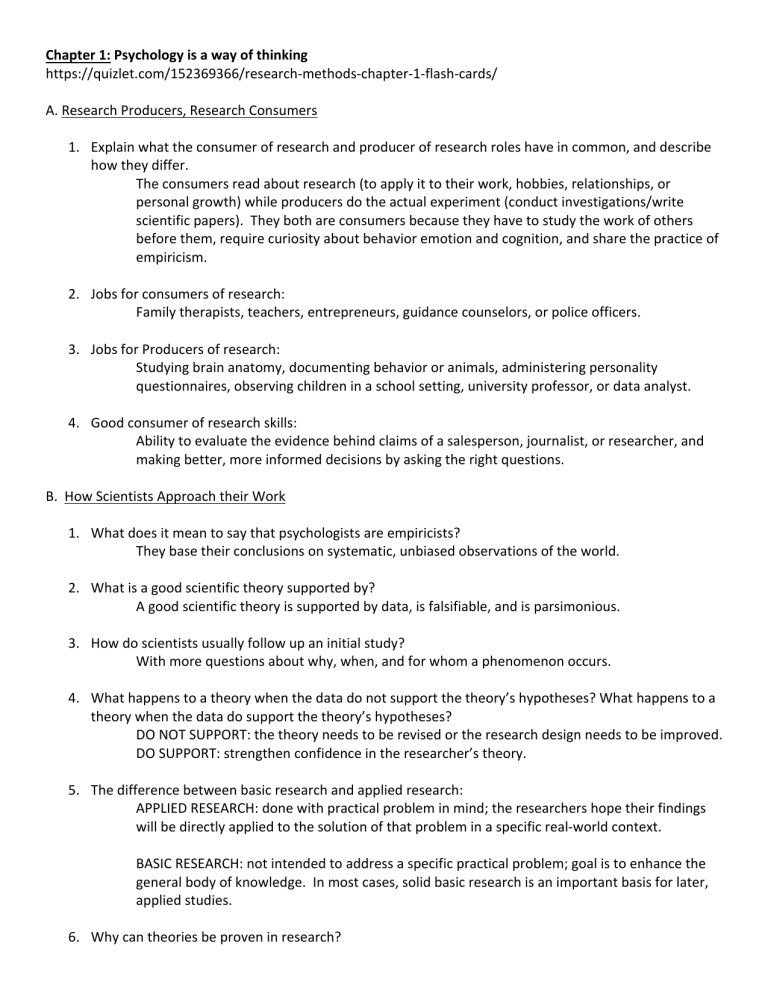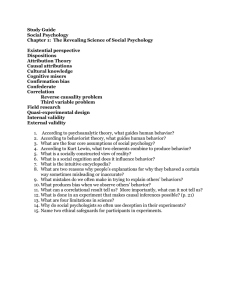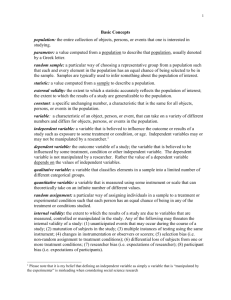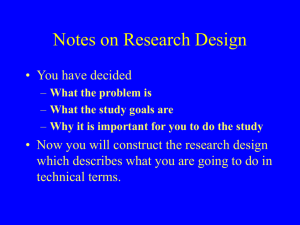Research Methods II Midterm Study Guide
advertisement

Chapter 1: Psychology is a way of thinking https://quizlet.com/152369366/research-­‐methods-­‐chapter-­‐1-­‐flash-­‐cards/ A. Research Producers, Research Consumers 1. Explain what the consumer of research and producer of research roles have in common, and describe how they differ. The consumers read about research (to apply it to their work, hobbies, relationships, or personal growth) while producers do the actual experiment (conduct investigations/write scientific papers). They both are consumers because they have to study the work of others before them, require curiosity about behavior emotion and cognition, and share the practice of empiricism. 2. Jobs for consumers of research: Family therapists, teachers, entrepreneurs, guidance counselors, or police officers. 3. Jobs for Producers of research: Studying brain anatomy, documenting behavior or animals, administering personality questionnaires, observing children in a school setting, university professor, or data analyst. 4. Good consumer of research skills: Ability to evaluate the evidence behind claims of a salesperson, journalist, or researcher, and making better, more informed decisions by asking the right questions. B. How Scientists Approach their Work 1. What does it mean to say that psychologists are empiricists? They base their conclusions on systematic, unbiased observations of the world. 2. What is a good scientific theory supported by? A good scientific theory is supported by data, is falsifiable, and is parsimonious. 3. How do scientists usually follow up an initial study? With more questions about why, when, and for whom a phenomenon occurs. 4. What happens to a theory when the data do not support the theory’s hypotheses? What happens to a theory when the data do support the theory’s hypotheses? DO NOT SUPPORT: the theory needs to be revised or the research design needs to be improved. DO SUPPORT: strengthen confidence in the researcher’s theory. 5. The difference between basic research and applied research: APPLIED RESEARCH: done with practical problem in mind; the researchers hope their findings will be directly applied to the solution of that problem in a specific real-­‐world context. BASIC RESEARCH: not intended to address a specific practical problem; goal is to enhance the general body of knowledge. In most cases, solid basic research is an important basis for later, applied studies. 6. Why can theories be proven in research? They’re based on the weight of evidence. Theory can be well supported or established, meaning that most of the data have confirmed the theory and very little have disconfirmed it. 7. Benefits of scientists publishing their data: The information is available to the public. Publication is an important part of the empirical process because doing so contributes to making empirical observations independently verifiable. 8. Two ways journalists might distort the science they attempt to publicize: They can create dramatic stories and they can dumb down the research to be easily accessible to audience. C. Additional Questions 1. To be an empiricist, one should: base one’s conclusions on direct observations. 2. A statement, or set of statements, that describes general principles about how variables relate to one another is: a theory. 3. Why is publication an important part of the empirical process? Because it contributes to making empirical observations independently verifiable. 4. Example of basic research question: can two-­‐month old infants discern the difference between for objects and 6 objects? D. Vocabulary: Evidence Based Treatment: Theories that are supported by research; helping professionals are required to know the research behind it. Data: set of observations (step 4 of cycle). Basic Research: not intended to address a specific, practical problem. The goal is to enhance the general body of knowledge. Empiricism: the use of evidence from senses or from instruments that assist the senses as basis for conclusions. They aim to be systematic and make their work independently verifiable by other observers or scientists. Falsifiability: theory must lead to a hypothesis that, when tested, could actually fail to support the theory. Theory: a set of statements that describes general principles about how variables relate to one another. (step 1 in theory data cycle) Hypothesis: or prediction; specific outcome the researcher expects to observe in a study if the theory is accurate. (step 3 in theory data cycle) Weight of the Evidence: scientists evaluate their theories based on it; weight for or against. Transitional Research: the use of lessons from basic research to develop and test applications to health care, psychotherapy, or other forms of treatment and intervention. Represents bridge from basic to applied research. Journal: Contains articles written by qualified contributors; for scientists that want to tell the world about their research results. They are peer-­‐ reviewed. Applied Research: done with practical problem in mind; researchers conduct work in a real-­‐world context. Parsimony: the degree to which theory provides the simplest explanation of some phenomenon. In investigating claim: simple explanation of data pattern; best explanation requires making fewest exceptions or qualifications. Chapter 2: Sources of Information – Why Research is Best and How to Find It A. Research vs. Your Experience: 1. What are two general problems with basing beliefs on experience? How does empirical research work to correct these problems? (1) some personal experiences won’t agree with the majority of experiences (2) they don’t have a comparison group and therefore can be confounded. Empirical research works to correct the problems by observing people as a group as compared to a single person so that we can get the most general answer. 2. What does it mean to say that research is probabilistic? Conclusions are meant to explain a certain proportion of possible cases, but may not explain them all. 3. Why does research have an advantage over experience? Because researchers design studies that have an appropriate comparison group. 4. What does it mean to say that conclusions based on research are probabilistic? Research findings can’t predict/explain all cases at the time. Rather, they strive to predict or explain high proportions of cases. Individual exceptions to research findings won’t nullify results. B. Research vs. Your Intuition: 1. This section described several ways in which intuition is biased. Can you name all five? (1) availability heuristic (2) present/present bias (3) confirmation bias (4) blind-­‐spot bias (5) being swayed by a good story. 2. Why is intuition a flawed source of information? Because it is affected by biases in thinking. People are likely to accept the explanation of a story that makes sense intuitively, even if it isn’t true. 3. Why do people find it easier to notice what is present than what is absent? When ppl forget to look at the information that would falsify their belief, they may see relationships that aren’t there. 4. Why is intuition subject to confirmation bias? We tend to focus on the data that support our ideas and criticize or discount the data that disagree. We ask leading questions whose answers are bound to confirm our initial ideas. 5. How do scientific researchers combat their potential for biased reasoning? They create special situations in which they can systematically observe behavior; they create comparison groups, consider all data, and allow the data to change their beliefs. 6. Why might the bias blind spot be the most sneaky of all the intuitive reasoning biases? Because we all have it but believe that we are less biased than everyone else. C. Trusting Authorities on the Subject: 1. When would it be sensible to accept the conclusions of authority figures? When might it not? When authorities base their conclusions on well-­‐conducted research (rather than experience or intuition), it may be reasonable to accept them. D. Finding and Reading the Research: 1. (a) How are empirical journal articles different from review journal articles? (b) How is each type of article different from a chapter in an edited book? (a) EJAs are reporting results of research study for the first time. It shares detail about the method, stat tests used, and the numerical results of the study. RJ articles provide summary of all published studies that have been done in one research area; they could summarize many studies on one topic and weighs each study proportionally. Both are peer reviewed and are prestigious forms of publication by psychological scientists. (b) In an edited book, the entire collection of chapters have common topics. Ch isnt usually the 1st place a study is reported. Chapters aren’t peer-­‐reviewed as rigorously as empirical journal articles or review articles, however editor is careful to invite only experts to partake in the writing of chapters. 2. What two guiding questions can help you read any academic research source? (1) what is the argument? (2) what is the research/evidence that supports the argument. 3. If you encounter a psychological trade book, what might indicate that the information it contains is research-­‐biased? Extensive reference list will signal that the information it contains is research based. 20+ pages of references is a good start. E. Additional Questions: 1. Destiny concluded that her new white noise machine helped her fall asleep last night. She based this conclusion on personal experience, which might have confounds. In this context, a confound means: Another thing may have occurred last night that helped destiny fall asleep. 2. After two students from his school commit suicide, Marcelino concludes that the most likely cause of death in teenagers is suicide. In fact, suicide is not the most likely cause of death in teens. What happened? M was probably influenced by the availability heuristic; he was too influenced by cases that came easily to mind. 3. When is it a good idea to base conclusions on the advice of authorities? When they based their advice on research that systematically and objectively compares different conditions. 4. Which of the following is not a place where psychological scientists publish their research? Online podcasts (they do in scientific journals, chapters in edited books, and full-­‐length books). 5. In reading an empirical journal article, what are the two questions you should be asking as you read? What is the argument? What is the evidence to support the argument? F. Vocabulary: Comparison Group: a group in an experiment whose levels on the independent variable differ from those of the treatment group in some intended/meaningful way. Probabilistic: describing the empirical method, stating that science is intended to explain a certain proportion (but not necessarily all) of the possible cases. Confirmation Bias: the tendency to consider only the evidence that supports a hypothesis, including asking only the questions that will lead to certain answers. Review Journal Article: Confound: general term for potential alternative explanation for a research finding; threat to internal validity. Confederate: an actor who is directed by the researcher to play a specific role in a research study. Availability Heuristic: bias in intuition; ppl incorrectly estimate the frequency of something, relying much on instances that easily come to mind rather than using all possible evidence in evaluating a conclusion. Present/Present Bias: intuition bias where ppl incorrectly estimate the relationship between an event and its outcome, focusing on times the event and outcome are present, while failing to consider evidence that is absent and harder to notice. Empirical Journal Article: a scholarly article that reports for the first time the results of a research study. Bias Blind Spot: the tendency for people to think that they compared to others, they themselves are less likely to engage in biased reasoning. Meta-­‐Analysis: way of mathematically averaging the effects sizes of all the studies that have tested the same variables to see what conclusion that whole body of evidence supports. Effect Size: the magnitude, or strength, of a relationship between 2 or more variables. G. Class Review Questions: Chapter 3: Three Claims, Four Validities – Interrogation Tools for Consumers of Research A. Variables: 1. What is the difference between a variable and its levels? What might be the levels of the variable “favorite color”? Variable implies that something varies and therefore must have at least 2 levels or values and can be manipulated. Favorite color would be the variable and the level would be the different colors. 2. Explain why some variables can only be measured, not manipulated. Can “gender” be a manipulated variable? Can “frequency of worrying” be a manipulated variable? Measured variables are only observed and recorded; manipulated variable is one a researcher controls, usually by assigning study participants to the different levels of that variable. Gender can probably not be manipulated while f of worrying probably can if the researcher assigned some ppl to purposely worry about something. 3. What is the difference between a conceptual variable and the operational definition of a variable? How might the conceptual variables “frequency of worrying,” “intelligence,” and “stress” be operationalized by a researcher? Conceptual variables (elements of a theory) are abstract concepts (e.g. spending time socializing/school achievement) that are sometimes called a construct. They must be carefully defined at the theoretical level – conceptual definitions – defines a specific concept. To test hypotheses, researchers have to do something specific in order to gather data. When testing their hypotheses with empirical research, they create operational definitions of variables – they turn concept of interest into measured or manipulated variable. It tells you how to measure it. Operationalize: (1) f of worrying: structure question in which ppl tell interviewer how often they worry or are relaxed. (2) Intelligence: IQ test? (3) Stress would be the same as 1. B. Three Claims: 1. Three types of claims that writers make about research: Frequency, association, and casual claims. 2. How many variables are there in a frequency claim? An association claim? A causal claim? F claim: 1 variable; association claim: at least 2; causal claim: 2 must be present. 3. Which part of speech in a claim can help you differentiate between association and causal claims? Causal claims use language to suggest that one variable causes the other such as cause, enhance, helps, leads to, adds, increases, and curbs. Association claims use words like risk for, predicts, is tied to, correlated with, likely, prefers. 4. How are causal claims special, compared with the other two claim types? They’re beyond a simple association btw two variables, using language to suggest that one variable causes the other; making a stronger statement. They only relate to experimental because there must be proof that they relate to each other, one came first, and no other explanations exist so that only comes from experimental studies not correlational. 5. What are the three criteria causal claims must satisfy? (1) must establish that the two variables are correlated (2) show that the causal variable came first and the outcome variable came later (3) establish that no other explanations exist for the relationship. C. Interrogating the Three Claims Using the Four Big Validities: 1. What question(s) would you use to interrogate a study’s (a) construct validity (b) external validity (c) statistical validity? (a) Ask about the quality of the measurements (b) is it generalizable to a larger population? (c) what is the degree of error in the percentage estimate? 2. In your own words, describe at least two things that statistical validity addresses. Stat validity is the extent to which the stat conclusions are accurate and reasonable. (1) strength of the association between variables and whether it is a strong or weak association. (2) Stat significance of certain association. (3) Stat validity helps the researcher or peer reviewer recognize when there is a correlation btw variables or when there might be mistakes such as type I (false positives) and type II (missing a correlation). 3. Define external validity, using the term generalize in your definition. It is how well the results of a study generalize (represent) people or contexts besides those in the study itself. 4. Why is a correlational study not able to support a causal claim? In this, the variables are measured. In a causal claim, the variables are manipulated and one variable caused changes in the other variable. 5. Why don’t researchers usually aim to achieve all four of the big validities at once? It is nearly impossible to conduct a study that satisfies all 4 validities at once. Researchers don’t even try to satisfy all 4 validities at times, only focusing on what their priorities are. D. Additional Questions: 1. Which of the following variable or variables is manipulated, rather than measured? (Could be more than one.) Amount of asprin a researcher gives a person to take: 325 or 500 mg. 2. Which of the following headlines is an association claim? Swine flu shot tied to narcolepsy, study finds. 3. Which of the following headlines is a frequency claim? Exercise: 45% of you shake your booty in Zumba. 4. Which of the following headlines is a causal claim? Taking a deep breath helps minimize high blood pressure, anxiety, and depression. 5. Which validity would you be interrogating by asking: How well did the researchers measure sensitivity to tastes in this study? Construct validity. 6. Which validity would you be interrogating by asking: How did the researchers get their sample of people for this survey? External validity. E. Vocabulary: Variable: attribute that varies, having at least 2 levels or values. Level: one of the possible variations, or values, of a variable. Constant: an attribute that could potentially vary but that only has one level in the study. Measured Variable: one whose levels (values) are observed/recorded. Conceptual Variable: variable of interest stated at an abstract, or conversational, level. Also called construct. Construct: variable of interest, stated in abstract level, usually defined as part of formal statement of a psychological theory. Conceptual Definition: researcher’s definition of a variable at the theoretical level. Operational Definition: specific way a concept of interest is measured or manipulated as a variable in a study. Manipulated Variable: one that is controlled by researcher such as by assigning participants to its different levels (values). Operational Variable: see operational definition. Operationalize: to turn conceptual definition of a variable into a specific measured variable or manipulated variable to conduct study. Correlational Study: study including 2+ variables, in which all variables are measured; can support association claim. Causal Claim: claim arguing that specific change in one variable is responsible for influencing the value of another. Claim: the argument a journalist, researcher, or scientist is trying to make. Statistical Validity: extent to which stat conclusion derived from a study are accurate and reasonable. Margin of Error of the Estimate: a stat, based in part on sample size, indicating the probable true value of a percentage estimate in the population. Temporal Precedence: 1/3 criteria for est a causal claim, stating that the proposed causal variable comes first in time, before the proposed outcome variable. Random Assignment: use of random method to assign participants into different experimental groups. Internal Validity: 1/3 criteria for est a causal claim; a study’s ability to rule out alt explanations for causal relationship btw 2 variables. Experiment: a study in which one variable is manipulated and the other is measured. Independent Variable: in experiment, variable that is manipulated. Content Validity: the extent to which a measure captures all parts of a defined construct. Positive Association: association in which high levels of 1 v go with high levels of other v, and low levels of one v go w low levels of other. Validity: appropriateness of a conclusion or decision. Frequency Claim: claim that describes a particular rate or degree of a single variable. Association Claim: a claim about 2 variables, in which the value (level) of one variable is said to vary systematically with value of another variable. Scatterplot: graphical Negative representation of an Association: high association, in which levels of one variable each dot represents go with low levels of one participant in the the other variable, study measured on and vice versa. two variables. Construct Validity: Generalizability: indication of how extent the subjects well a variable was rep the populations measured or they are indented to manipulated in a represent; how well study. the settings in a study represent other settings or contexts. Type I Error: “false Type II Error: “miss” positive” result in in the stat inference statistical inference process, in which process, in which researchers conclude researchers conclude that their study has that there’s an effect not detected an in a population, effect in a when there really is population, when none. there really is one. Correlate: to occur or vary together (covary) systematically, as in the case of 2 variables. Zero Association: lack of systematic association btw 2 variables. External Validity: an indication of how well the results of a study generalize to, or represent, individuals or contexts besides those in the study itself. Covariance: the degree to which 2 variables go together. Also, one of 3 criteria for est a causal claim – states that in a study’s results, the proposed causal variable must vary systematically with changes in the proposed outcome variable. Dependent Variable: In experiment, it is the measured variable. This one depends on the independent one. Chapter 4: Ethical Guidelines for Psychology Research A. Historical Examples: B. Core Ethical Principles: C. Guidelines for Psychologists: D. Ethical Decision Making – A Thoughtful Balance:





